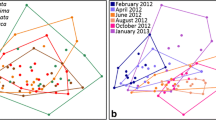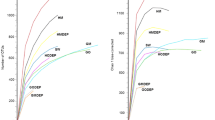Abstract
Withering syndrome (WS) is a gastro-intestinal (GI) infectious disease likely affecting all abalone species worldwide. Structural and functional changes in abalone GI microbiotas under WS-stressed conditions remain poorly investigated. It is unclear if interspecific microbiota differences, such as the presence of certain microbes, their abundance, and functional capabilities, may be involved in the occurrence of this disease. Bacterial microbiotas of healthy Haliotis fulgens and Haliotis corrugata are mainly composed by Tenericutes, Proteobacteria, Fusobacteria, and Spirochaetes. We previously reported species-specific structural and functional profiles of those communities and suggested that they are of consequence to the different susceptibility of each species to WS. Here, we address this question by comparing the structure and function of healthy and dysbiotic microbiota through 454 pyrosequencing and PICRUSt 2, respectively. Our findings suggest that the extent to which WS-stressed conditions may explain structural and functional differences in GI microbiota is contingent on the microbiota diversity itself. Indeed, microbiota differences between stressed and healthy abalone were marginal in the more complex bacterial communities of H. corrugata, in which no significant structural or functional changes were detected. Conversely, significant structural changes were observed in the less complex bacterial microbiota of H. fulgens. Moreover, structural alterations led to a significant downregulation of some metabolic activities conducted by GI bacteria. Accordingly, results suggest that gastro-intestinal bacterial diversity appears to be related with both the health of abalone and the etiology of WS.




Similar content being viewed by others
Availability of Data and Materials
Raw reads were deposited in the National Center for Biotechnology Information (NCBI; BioProject: PRJNA494699, accession number: SRR7969002).
Code Availability
Not applicable.
References
Moore JD, Byron SN, Marshman BC, Snider JP (2019) An oxytetracycline bath protocol to eliminate the agent of withering syndrome, Candidatus Xenohaliotis californiensis, in captive abalone populations. Aquaculture 503:267–274. https://doi.org/10.1016/j.aquaculture.2019.01.014
Miner CM, Altstatt JM, Raimondi PT, Minchinton TE (2006) Recruitment failure and shifts in community structure following mass mortality limit recovery prospects of black abalone. Mar Ecol Prog Ser 327:107–117. https://doi.org/10.3354/meps327107
Crosson LM, Friedman CS (2018) Withering syndrome susceptibility of northeastern Pacific abalones: a complex relationship with phylogeny and thermal experience. J Invertebr Pathol 151:91–101. https://doi.org/10.1016/j.jip.2017.11.005
Lee MJ, Lee JJ, Han YC et al (2016) Analysis of microbiota on abalone (Haliotis discus hannai) in South Korea for improved product management. Int J Food Microbiol 234:45–52. https://doi.org/10.1016/j.ijfoodmicro.2016.06.032
Vater A, Byrne BA, Marshman BC et al (2018) Differing responses of red abalone (Haliotis rufescens) and white abalone (H. sorenseni) to infection with phage-associated Candidatus Xenohaliotis californiensis. PeerJ 6:e5104. https://doi.org/10.7717/peerj.5104
Morales-Bojórquez E, Muciño-Díaz MO, Vélez-Barajas JA (2008) Analysis of the decline of the abalone fishery (Haliotis fulgens and H. corrugata) along the westcentral coast of the Baja California Peninsula. Mexico J Shellfish Res 27:865–870. https://doi.org/10.2983/0730-8000(2008)27[865:AOTDOT]2.0.CO;2
Cáceres-Martínez J, Vásquez-Yeomans R, Flores-Saaib RD (2011) Intracellular prokaryote Xenohaliotis californiensis in abalone Haliotis spp. from Baja California. México Cienc Pesq 19:5–11
Cicala F, Moore JD, Cáceres-Martínez J et al (2017) Multigenetic characterization of ‘Candidatus Xenohaliotis californiensis’. Int J Syst Evol Microbiol 67:42–49. https://doi.org/10.1099/ijsem.0.001563
Friedman CS, Andree KB, Beauchamp KA et al (2000) ‘Candidatus Xenohaliotis californiensis‘, a newly described pathogen of abalone, Haliotis spp., along the west coast of North America. Int J Syst Evol Microbiol 50:847–855
Álvarez Tinajero MDC, Cáceres-Martínez J, Gonzáles Avilés JG et al (2002) Histopathological evaluation of the yellow abalone Haliotis corrugata and the blue abalone Haliotis fulgens from Baja California. México J Shellfish Res 21:825–830
Horwitz R, Mouton A, Coyne VE (2016) Characterization of an intracellular bacterium infecting the digestive gland of the South African abalone Haliotis midae. Aquaculture 451:24–32. https://doi.org/10.1016/j.aquaculture.2015.08.024
McFall-Ngai M, Hadfield MG, Bosch TCG et al (2013) Animals in a bacterial world, a new imperative for the life sciences. Proc Natl Acad Sci U S A 110:3229–3236. https://doi.org/10.1073/pnas.1218525110
Zaneveld JR, McMinds R, Thurber RV (2017) Stress and stability: applying the Anna Karenina principle to animal microbiomes. Nat Microbiol 2:1–8. https://doi.org/10.1038/nmicrobiol.2017.121
Mallott EK, Amato KR (2021) Host specificity of the gut microbiome. Nat Rev Microbiol 19(10):639–653. https://doi.org/10.1038/s41579-021-00562-3
Libertucci J, Young VB (2019) The role of the microbiota in infectious diseases. Nat Microbiol 4:35–45. https://doi.org/10.1038/s41564-018-0278-4
Yachi S, Loreau M (1999) Biodiversity and ecosystem productivity in a fluctuating environment: the insurance hypothesis. Proc Natl Acad Sci U S A 96:1463–1468. https://doi.org/10.1073/pnas.96.4.1463
Larsen OFA, Claassen E (2018) The mechanistic link between health and gut microbiota diversity. Sci Rep 8:6–10. https://doi.org/10.1038/s41598-018-20141-6
Gobet A, Mest L, Perennou M et al (2018) Seasonal and algal diet-driven patterns of the digestive microbiota of the European abalone Haliotis tuberculata, a generalist marine herbivore. Microbiome 6:60. https://doi.org/10.1186/s40168-018-0430-7
Zaneveld JR, Burkepile DE, Shantz AA et al (2016) Overfishing and nutrient pollution interact with temperature to disrupt coral reefs down to microbial scales. Nat Commun 7:1–12. https://doi.org/10.1038/ncomms11833
Villasante A, Catalán N, Rojas R et al (2020) Microbiota of the digestive gland of red abalone (Haliotis rufescens) is affected by withering syndrome. Microorganisms 8:1–13. https://doi.org/10.3390/microorganisms8091411
Cicala F, Cisterna-Celiz JA, Moore JD, Rocha-Olivares A (2018) Structure, dynamics and predicted functional ecology of the gut microbiota of the blue (Haliotis fulgens) and yellow (H . corrugata) abalone from Baja California Sur, Mexico. PeerJ 5:e3233v1. https://doi.org/10.7717/peerj.5830
Friedman CS (2012) Infection with Xenohaliotis californiensis. Man Diagnostic Tests Aquat Anim 511–523
Ludwig W, Mittenhuber G, Friedrich CG (1993) Transfer of Thiosphaera pantotropha to Paracoccus denitrificans. Int J Syst Bacteriol 43:363–367. https://doi.org/10.1099/00207713-43-2-363
Ruff-Roberts AL, Kuenen JG, Ward DM (1994) Distribution of cultivated and uncultivated cyanobacteria and Chloroflexus-like bacteria in hot spring microbial mats. Appl Environ Microbiol 60:697–704
Dowd SE, Callaway TR, Wolcott RD et al (2008) Evaluation of the bacterial diversity in the feces of cattle using 16S rDNA bacterial tag-encoded FLX amplicon pyrosequencing (bTEFAP). BMC Microbiol 8:125. https://doi.org/10.1186/1471-2180-8-125
Edgar RC (2010) Search and clustering orders of magnitude faster than BLAST. Bioinformatics 26:2460–2461. https://doi.org/10.1093/bioinformatics/btq461
Bolyen E, Rideout J, Dillon M et al (2019) Reproducible, interactive, scalable and extensible microbiome data science using QIIME 2. Nat Biotechnol 37:852–857
Rognes T, Flouri T, Nichols B et al (2016) VSEARCH: a versatile open source tool for metagenomics. PeerJ 4:e2584. https://doi.org/10.7717/peerj.2584
Edgar RC, Haas BJ, Clemente JC et al (2011) UCHIME improves sensitivity and speed of chimera detection. Bioinformatics 27:2194–2200. https://doi.org/10.1093/bioinformatics/btr381
Camacho C, Coulouris G, Avagyan V et al (2009) BLAST+: architecture and applications. BMC Bioinformatics 10:1–9. https://doi.org/10.1186/1471-2105-10-421
Quast C, Pruesse E, Yilmaz P et al (2013) The SILVA ribosomal RNA gene database project: improved data processing and web-based tools. Nucleic Acids Res 41:590–596. https://doi.org/10.1093/nar/gks1219
Bokulich NA, Subramanian S, Faith JJ et al (2013) Quality-filtering vastly improves diversity estimates from Illumina amplicon sequencing. Nat Methods 10:57–59. https://doi.org/10.1038/nmeth.2276.Quality-filtering
Chao A (1984) Nonparametric estimation of the number of classes in a population. Scanadinavian J Stat 11:265–270. https://doi.org/10.1214/aoms/1177729949
Vázquez-Baeza Y, Pirrung M, Gonzalez A, Knight R (2013) EMPeror : a tool for visualizing high-throughput microbial community data. Gigascience 2:1–4
Anderson MJ (2001) A new method for non-parametric multivariate analysis of variance. Austral Ecol 26:32–46. https://doi.org/10.1080/13645700903062353
Clarke KR, Warwick RM (2001) A further biodiversity index applicable to species lists: variation in taxonomic distinctness. Mar Ecol Prog Ser 216:265–278. https://doi.org/10.3354/meps216265
Heberle H, Meirelles VG, da Silva FR et al (2015) InteractiVenn: a web-based tool for the analysis of sets through Venn diagrams. BMC Bioinformatics 16:1–7. https://doi.org/10.1186/s12859-015-0611-3
Segata N, Izard J, Waldron L et al (2011) Metagenomic biomarker discovery and explanation. Genome Biol 12:1–18. https://doi.org/10.1186/gb-2011-12-6-r60
Douglas GM, Maffei VJ, Zaneveld J et al (2019) PICRUSt2: an improved and extensible approach for metagenome inference. BioRxiv 1:42. https://doi.org/10.3997/2214-4609.201404048
Langille M, Zaneveld J, Caporaso JG et al (2013) Predictive functional profiling of microbial communities using 16S rRNA marker gene sequences. Nat Biotechnol 31:814–821. https://doi.org/10.1038/nbt.2676
de Voogd NJ, Cleary DFR, Polónia ARM, Gomes NCM (2015) Bacterial community composition and predicted functional ecology of sponges, sediment and seawater from the thousand islands reef complex, West Java, Indonesia. FEMS Microbiol Ecol 91:1–12. https://doi.org/10.1093/femsec/fiv019
Parks DH, Tyson GW, Hugenholtz P, Beiko RG (2014) STAMP: statistical analysis of taxonomic and functional profiles. Bioinformatics 30:3123–3124. https://doi.org/10.1093/bioinformatics/btu494
Moore JD, Juhasz CI, Robbins TT, Ignacio Vilchis L (2009) Green abalone, Haliotis fulgens infected with the agent of withering syndrome do not express disease signs under a temperature regime permissive for red abalone, Haliotis rufescens. Mar Biol 156:2325–2330. https://doi.org/10.1007/s00227-009-1260-8
Harris VC, Haak BW, Boele van Hensbroek M, Wiersinga WJ (2017) The intestinal microbiome in infectious diseases: the clinical relevance of a rapidly emerging field. Open Forum Infect Dis 4:1–8. https://doi.org/10.1093/ofid/ofx144
Offret C, Jégou C, Mounier J et al (2019) New insights into the haemo- and coelo-microbiota with antimicrobial activities from Echinodermata and Mollusca. J Appl Microbiol 126:1023–1031. https://doi.org/10.1111/jam.14184
Birhanu AG, Yimer SA, Kalayou S et al (2019) Ample glycosylation in membrane and cell envelope proteins may explain the phenotypic diversity and virulence in the Mycobacterium tuberculosis complex. Sci Rep 9:1–15. https://doi.org/10.1038/s41598-019-39654-9
Wang Y, Huang JM, Wang SL et al (2016) Genomic characterization of symbiotic mycoplasmas from the stomach of deep-sea isopod bathynomus sp. Environ Microbiol 18:2646–2659. https://doi.org/10.1111/1462-2920.13411
Acknowledgements
We are grateful to Dr. W. Kelley Thomas for providing us with the possibility of running bioinformatics pipelines using the server of the Research Computing Center of the University of New Hampshire and Andrea Lievana-MacTavish for English language editing.
Funding
This study was supported by SAGARPA-CONACYT [grant number 2011-C01-163322], UC Mexus-CONACYT [grant number CN-14–14], and the Fund for Scientific Research and Technological Development of CICESE [grant number FID-2012–01]. The first author received a graduate fellowship from CONACYT to support his Ph.D. research in Marine Ecology at the Centro de Investigación Científica y de Educación Superior de Ensenada (CICESE). sagarpa-conacyt,2011-CO1-163322,Axayácatl Rocha-Olivares,uc mexus-conacyt,CN-14–14,Axayácatl Rocha-Olivares,cicese,Fund for Scientific Research,Axayácatl Rocha-Olivares,Technological Development FID-2012–01,Axayácatl Rocha-Olivares
Author information
Authors and Affiliations
Contributions
Experimental design: Francesco Cicala, James D. Moore, and Axayácatl Rocha-Olivares. Data collection and preparation: Francesco Cicala. Bioinformatics analysis: Francesco Cicala, José Alejandro Cisterna-Céliz, Marcos Paolinelli, and Joseph Sevigny. Funding acquisition: Axayácatl Rocha-Olivares and James D. Moore. The first draft of the manuscript was written by Francesco Cicala and all authors commented on previous versions of the manuscript. All authors read and approved the final manuscript.
Corresponding author
Ethics declarations
Ethics Approval
Not applicable.
Consent to Participate
Not applicable.
Consent for Publication
Not applicable.
Competing Interests
The authors declare no competing interests.
Supplementary Information
Below is the link to the electronic supplementary material.
Rights and permissions
About this article
Cite this article
Cicala, F., Cisterna-Céliz, J.A., Paolinelli, M. et al. The Role of Diversity in Mediating Microbiota Structural and Functional Differences in Two Sympatric Species of Abalone Under Stressed Withering Syndrome Conditions. Microb Ecol 85, 277–287 (2023). https://doi.org/10.1007/s00248-022-01970-5
Received:
Accepted:
Published:
Issue Date:
DOI: https://doi.org/10.1007/s00248-022-01970-5




